Management Accounting: Cost Analysis, Budgeting and Control Methods
VerifiedAdded on 2023/06/14
|22
|5873
|194
Report
AI Summary
This report provides a detailed overview of management accounting, covering its definition, purpose, and various systems such as cost accounting, inventory management, price optimization, and job costing. It explores different management accounting reporting methods, including budget reports, accounts receivable aging reports, job cost reports, inventory and manufacturing reports, performance reports, and order information reports. The report also includes a cost analysis using marginal and absorption costing methods to prepare income statements under different sales scenarios, highlighting the impact of varying sales volumes on profitability. Additionally, it discusses various planning techniques for budgetary control, weighing the advantages and disadvantages of each method, and examines how organizations prioritize management accounting systems to address financial challenges, emphasizing the role of management accounting in decision-making and financial problem-solving.
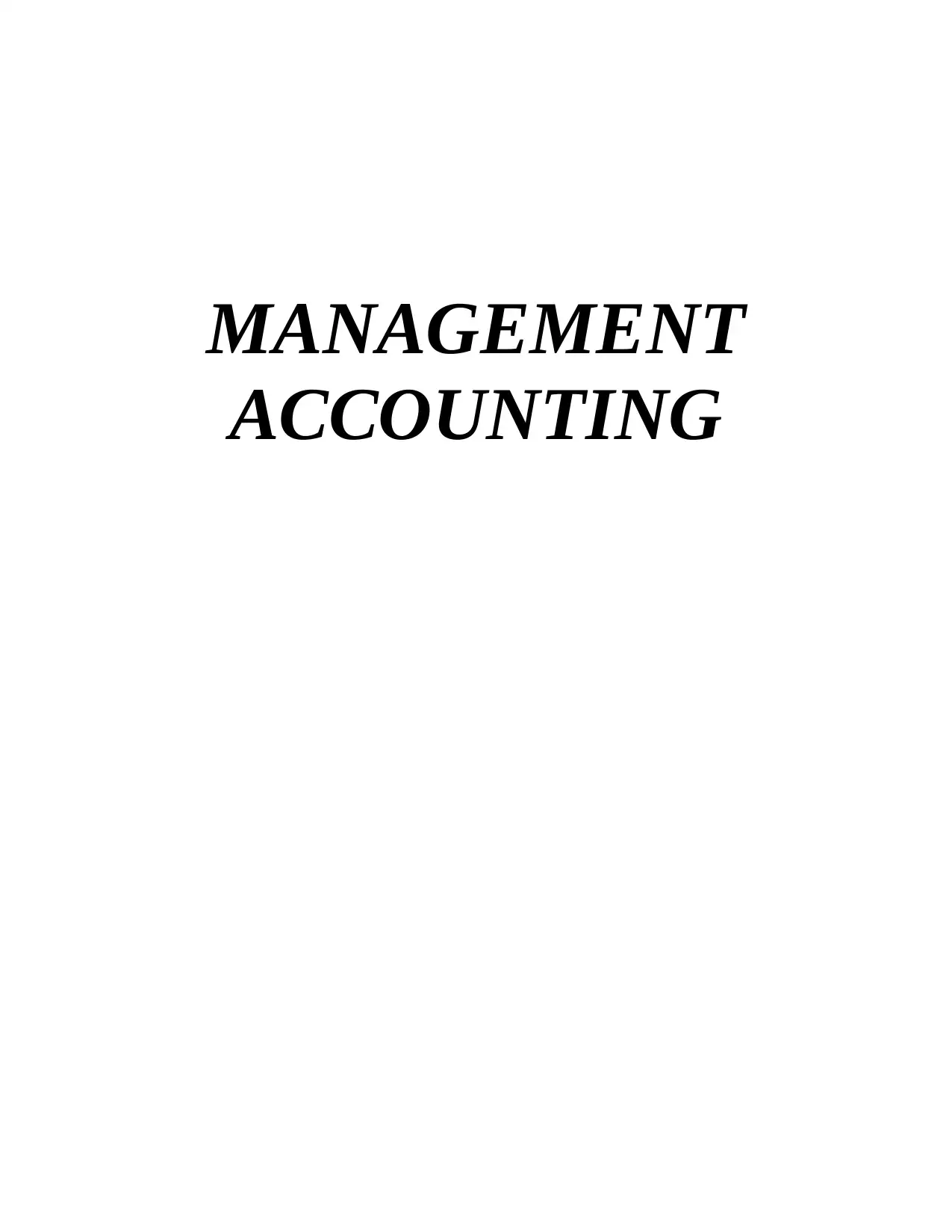
MANAGEMENT
ACCOUNTING
ACCOUNTING
Paraphrase This Document
Need a fresh take? Get an instant paraphrase of this document with our AI Paraphraser
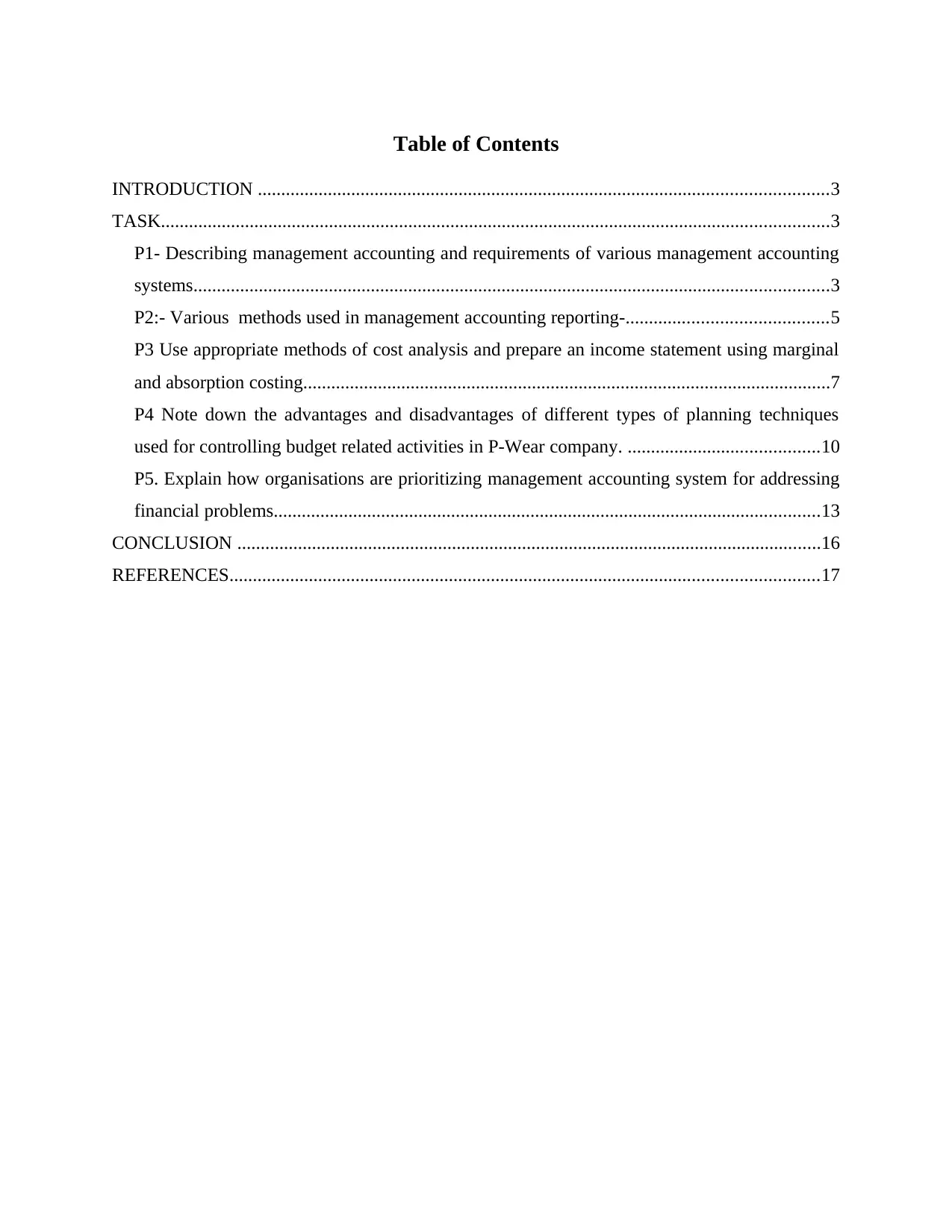
Table of Contents
INTRODUCTION ..........................................................................................................................3
TASK...............................................................................................................................................3
P1- Describing management accounting and requirements of various management accounting
systems........................................................................................................................................3
P2:- Various methods used in management accounting reporting-...........................................5
P3 Use appropriate methods of cost analysis and prepare an income statement using marginal
and absorption costing.................................................................................................................7
P4 Note down the advantages and disadvantages of different types of planning techniques
used for controlling budget related activities in P-Wear company. .........................................10
P5. Explain how organisations are prioritizing management accounting system for addressing
financial problems.....................................................................................................................13
CONCLUSION .............................................................................................................................16
REFERENCES..............................................................................................................................17
INTRODUCTION ..........................................................................................................................3
TASK...............................................................................................................................................3
P1- Describing management accounting and requirements of various management accounting
systems........................................................................................................................................3
P2:- Various methods used in management accounting reporting-...........................................5
P3 Use appropriate methods of cost analysis and prepare an income statement using marginal
and absorption costing.................................................................................................................7
P4 Note down the advantages and disadvantages of different types of planning techniques
used for controlling budget related activities in P-Wear company. .........................................10
P5. Explain how organisations are prioritizing management accounting system for addressing
financial problems.....................................................................................................................13
CONCLUSION .............................................................................................................................16
REFERENCES..............................................................................................................................17
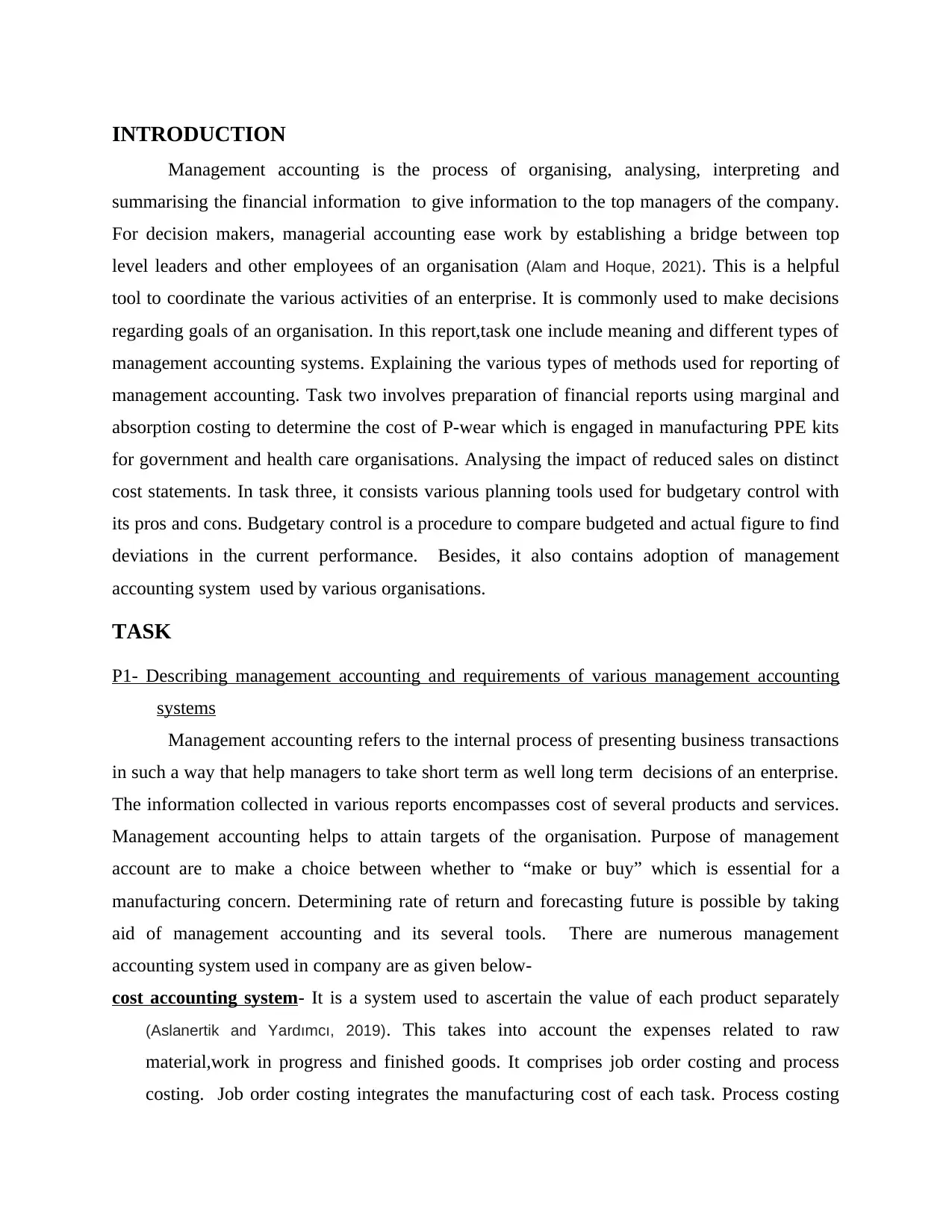
INTRODUCTION
Management accounting is the process of organising, analysing, interpreting and
summarising the financial information to give information to the top managers of the company.
For decision makers, managerial accounting ease work by establishing a bridge between top
level leaders and other employees of an organisation (Alam and Hoque, 2021). This is a helpful
tool to coordinate the various activities of an enterprise. It is commonly used to make decisions
regarding goals of an organisation. In this report,task one include meaning and different types of
management accounting systems. Explaining the various types of methods used for reporting of
management accounting. Task two involves preparation of financial reports using marginal and
absorption costing to determine the cost of P-wear which is engaged in manufacturing PPE kits
for government and health care organisations. Analysing the impact of reduced sales on distinct
cost statements. In task three, it consists various planning tools used for budgetary control with
its pros and cons. Budgetary control is a procedure to compare budgeted and actual figure to find
deviations in the current performance. Besides, it also contains adoption of management
accounting system used by various organisations.
TASK
P1- Describing management accounting and requirements of various management accounting
systems
Management accounting refers to the internal process of presenting business transactions
in such a way that help managers to take short term as well long term decisions of an enterprise.
The information collected in various reports encompasses cost of several products and services.
Management accounting helps to attain targets of the organisation. Purpose of management
account are to make a choice between whether to “make or buy” which is essential for a
manufacturing concern. Determining rate of return and forecasting future is possible by taking
aid of management accounting and its several tools. There are numerous management
accounting system used in company are as given below-
cost accounting system- It is a system used to ascertain the value of each product separately
(Aslanertik and Yardımcı, 2019). This takes into account the expenses related to raw
material,work in progress and finished goods. It comprises job order costing and process
costing. Job order costing integrates the manufacturing cost of each task. Process costing
Management accounting is the process of organising, analysing, interpreting and
summarising the financial information to give information to the top managers of the company.
For decision makers, managerial accounting ease work by establishing a bridge between top
level leaders and other employees of an organisation (Alam and Hoque, 2021). This is a helpful
tool to coordinate the various activities of an enterprise. It is commonly used to make decisions
regarding goals of an organisation. In this report,task one include meaning and different types of
management accounting systems. Explaining the various types of methods used for reporting of
management accounting. Task two involves preparation of financial reports using marginal and
absorption costing to determine the cost of P-wear which is engaged in manufacturing PPE kits
for government and health care organisations. Analysing the impact of reduced sales on distinct
cost statements. In task three, it consists various planning tools used for budgetary control with
its pros and cons. Budgetary control is a procedure to compare budgeted and actual figure to find
deviations in the current performance. Besides, it also contains adoption of management
accounting system used by various organisations.
TASK
P1- Describing management accounting and requirements of various management accounting
systems
Management accounting refers to the internal process of presenting business transactions
in such a way that help managers to take short term as well long term decisions of an enterprise.
The information collected in various reports encompasses cost of several products and services.
Management accounting helps to attain targets of the organisation. Purpose of management
account are to make a choice between whether to “make or buy” which is essential for a
manufacturing concern. Determining rate of return and forecasting future is possible by taking
aid of management accounting and its several tools. There are numerous management
accounting system used in company are as given below-
cost accounting system- It is a system used to ascertain the value of each product separately
(Aslanertik and Yardımcı, 2019). This takes into account the expenses related to raw
material,work in progress and finished goods. It comprises job order costing and process
costing. Job order costing integrates the manufacturing cost of each task. Process costing
⊘ This is a preview!⊘
Do you want full access?
Subscribe today to unlock all pages.

Trusted by 1+ million students worldwide
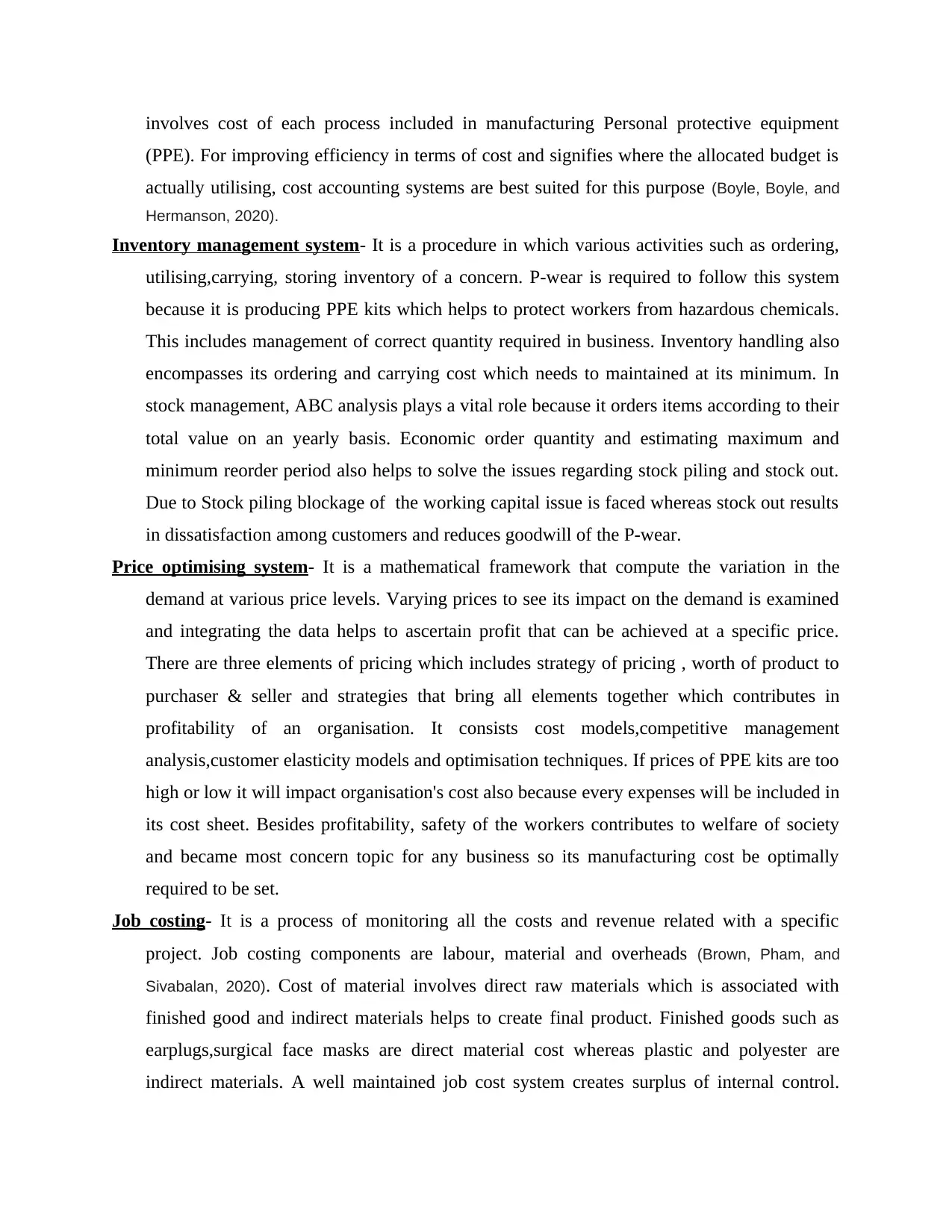
involves cost of each process included in manufacturing Personal protective equipment
(PPE). For improving efficiency in terms of cost and signifies where the allocated budget is
actually utilising, cost accounting systems are best suited for this purpose (Boyle, Boyle, and
Hermanson, 2020).
Inventory management system- It is a procedure in which various activities such as ordering,
utilising,carrying, storing inventory of a concern. P-wear is required to follow this system
because it is producing PPE kits which helps to protect workers from hazardous chemicals.
This includes management of correct quantity required in business. Inventory handling also
encompasses its ordering and carrying cost which needs to maintained at its minimum. In
stock management, ABC analysis plays a vital role because it orders items according to their
total value on an yearly basis. Economic order quantity and estimating maximum and
minimum reorder period also helps to solve the issues regarding stock piling and stock out.
Due to Stock piling blockage of the working capital issue is faced whereas stock out results
in dissatisfaction among customers and reduces goodwill of the P-wear.
Price optimising system- It is a mathematical framework that compute the variation in the
demand at various price levels. Varying prices to see its impact on the demand is examined
and integrating the data helps to ascertain profit that can be achieved at a specific price.
There are three elements of pricing which includes strategy of pricing , worth of product to
purchaser & seller and strategies that bring all elements together which contributes in
profitability of an organisation. It consists cost models,competitive management
analysis,customer elasticity models and optimisation techniques. If prices of PPE kits are too
high or low it will impact organisation's cost also because every expenses will be included in
its cost sheet. Besides profitability, safety of the workers contributes to welfare of society
and became most concern topic for any business so its manufacturing cost be optimally
required to be set.
Job costing- It is a process of monitoring all the costs and revenue related with a specific
project. Job costing components are labour, material and overheads (Brown, Pham, and
Sivabalan, 2020). Cost of material involves direct raw materials which is associated with
finished good and indirect materials helps to create final product. Finished goods such as
earplugs,surgical face masks are direct material cost whereas plastic and polyester are
indirect materials. A well maintained job cost system creates surplus of internal control.
(PPE). For improving efficiency in terms of cost and signifies where the allocated budget is
actually utilising, cost accounting systems are best suited for this purpose (Boyle, Boyle, and
Hermanson, 2020).
Inventory management system- It is a procedure in which various activities such as ordering,
utilising,carrying, storing inventory of a concern. P-wear is required to follow this system
because it is producing PPE kits which helps to protect workers from hazardous chemicals.
This includes management of correct quantity required in business. Inventory handling also
encompasses its ordering and carrying cost which needs to maintained at its minimum. In
stock management, ABC analysis plays a vital role because it orders items according to their
total value on an yearly basis. Economic order quantity and estimating maximum and
minimum reorder period also helps to solve the issues regarding stock piling and stock out.
Due to Stock piling blockage of the working capital issue is faced whereas stock out results
in dissatisfaction among customers and reduces goodwill of the P-wear.
Price optimising system- It is a mathematical framework that compute the variation in the
demand at various price levels. Varying prices to see its impact on the demand is examined
and integrating the data helps to ascertain profit that can be achieved at a specific price.
There are three elements of pricing which includes strategy of pricing , worth of product to
purchaser & seller and strategies that bring all elements together which contributes in
profitability of an organisation. It consists cost models,competitive management
analysis,customer elasticity models and optimisation techniques. If prices of PPE kits are too
high or low it will impact organisation's cost also because every expenses will be included in
its cost sheet. Besides profitability, safety of the workers contributes to welfare of society
and became most concern topic for any business so its manufacturing cost be optimally
required to be set.
Job costing- It is a process of monitoring all the costs and revenue related with a specific
project. Job costing components are labour, material and overheads (Brown, Pham, and
Sivabalan, 2020). Cost of material involves direct raw materials which is associated with
finished good and indirect materials helps to create final product. Finished goods such as
earplugs,surgical face masks are direct material cost whereas plastic and polyester are
indirect materials. A well maintained job cost system creates surplus of internal control.
Paraphrase This Document
Need a fresh take? Get an instant paraphrase of this document with our AI Paraphraser
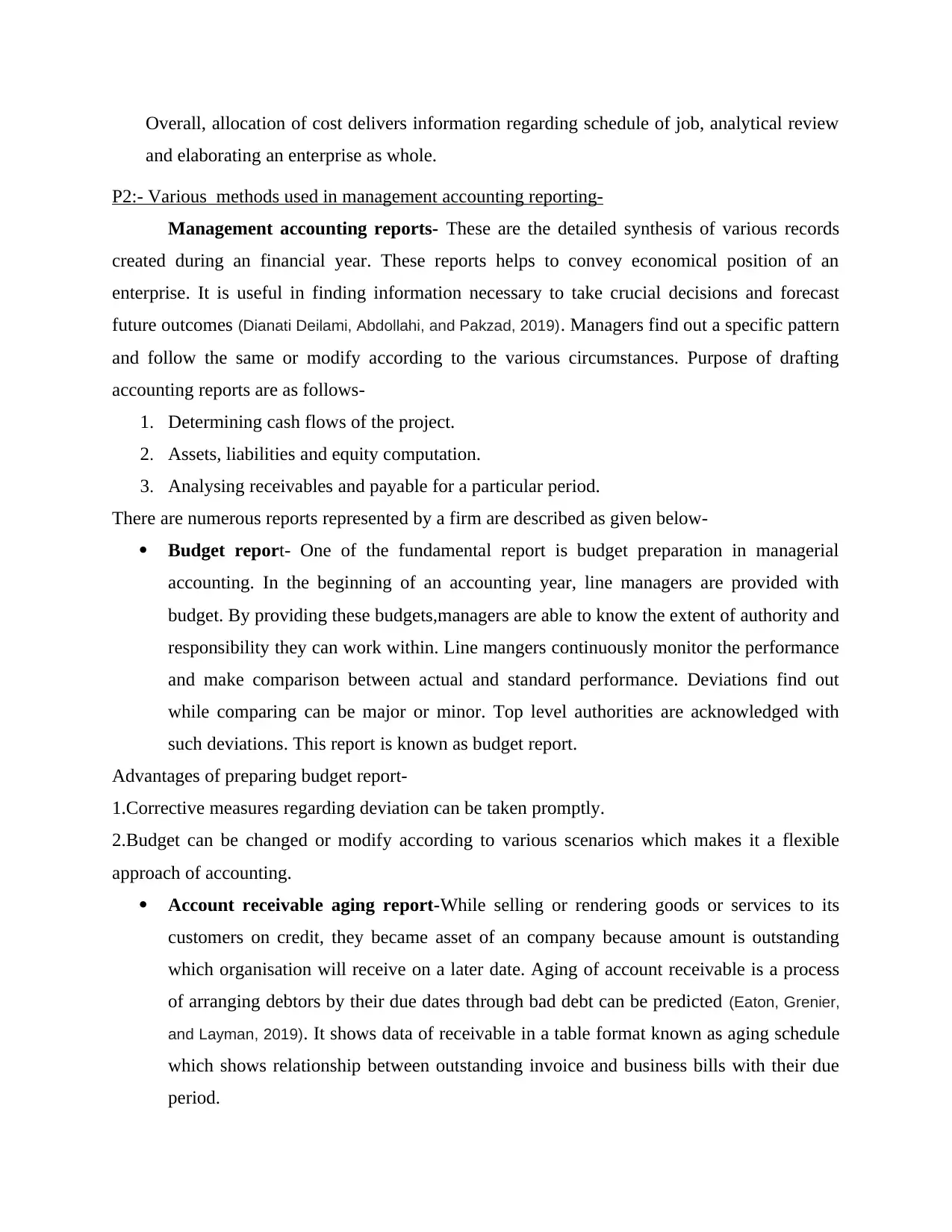
Overall, allocation of cost delivers information regarding schedule of job, analytical review
and elaborating an enterprise as whole.
P2:- Various methods used in management accounting reporting-
Management accounting reports- These are the detailed synthesis of various records
created during an financial year. These reports helps to convey economical position of an
enterprise. It is useful in finding information necessary to take crucial decisions and forecast
future outcomes (Dianati Deilami, Abdollahi, and Pakzad, 2019). Managers find out a specific pattern
and follow the same or modify according to the various circumstances. Purpose of drafting
accounting reports are as follows-
1. Determining cash flows of the project.
2. Assets, liabilities and equity computation.
3. Analysing receivables and payable for a particular period.
There are numerous reports represented by a firm are described as given below-
Budget report- One of the fundamental report is budget preparation in managerial
accounting. In the beginning of an accounting year, line managers are provided with
budget. By providing these budgets,managers are able to know the extent of authority and
responsibility they can work within. Line mangers continuously monitor the performance
and make comparison between actual and standard performance. Deviations find out
while comparing can be major or minor. Top level authorities are acknowledged with
such deviations. This report is known as budget report.
Advantages of preparing budget report-
1.Corrective measures regarding deviation can be taken promptly.
2.Budget can be changed or modify according to various scenarios which makes it a flexible
approach of accounting.
Account receivable aging report-While selling or rendering goods or services to its
customers on credit, they became asset of an company because amount is outstanding
which organisation will receive on a later date. Aging of account receivable is a process
of arranging debtors by their due dates through bad debt can be predicted (Eaton, Grenier,
and Layman, 2019). It shows data of receivable in a table format known as aging schedule
which shows relationship between outstanding invoice and business bills with their due
period.
and elaborating an enterprise as whole.
P2:- Various methods used in management accounting reporting-
Management accounting reports- These are the detailed synthesis of various records
created during an financial year. These reports helps to convey economical position of an
enterprise. It is useful in finding information necessary to take crucial decisions and forecast
future outcomes (Dianati Deilami, Abdollahi, and Pakzad, 2019). Managers find out a specific pattern
and follow the same or modify according to the various circumstances. Purpose of drafting
accounting reports are as follows-
1. Determining cash flows of the project.
2. Assets, liabilities and equity computation.
3. Analysing receivables and payable for a particular period.
There are numerous reports represented by a firm are described as given below-
Budget report- One of the fundamental report is budget preparation in managerial
accounting. In the beginning of an accounting year, line managers are provided with
budget. By providing these budgets,managers are able to know the extent of authority and
responsibility they can work within. Line mangers continuously monitor the performance
and make comparison between actual and standard performance. Deviations find out
while comparing can be major or minor. Top level authorities are acknowledged with
such deviations. This report is known as budget report.
Advantages of preparing budget report-
1.Corrective measures regarding deviation can be taken promptly.
2.Budget can be changed or modify according to various scenarios which makes it a flexible
approach of accounting.
Account receivable aging report-While selling or rendering goods or services to its
customers on credit, they became asset of an company because amount is outstanding
which organisation will receive on a later date. Aging of account receivable is a process
of arranging debtors by their due dates through bad debt can be predicted (Eaton, Grenier,
and Layman, 2019). It shows data of receivable in a table format known as aging schedule
which shows relationship between outstanding invoice and business bills with their due
period.
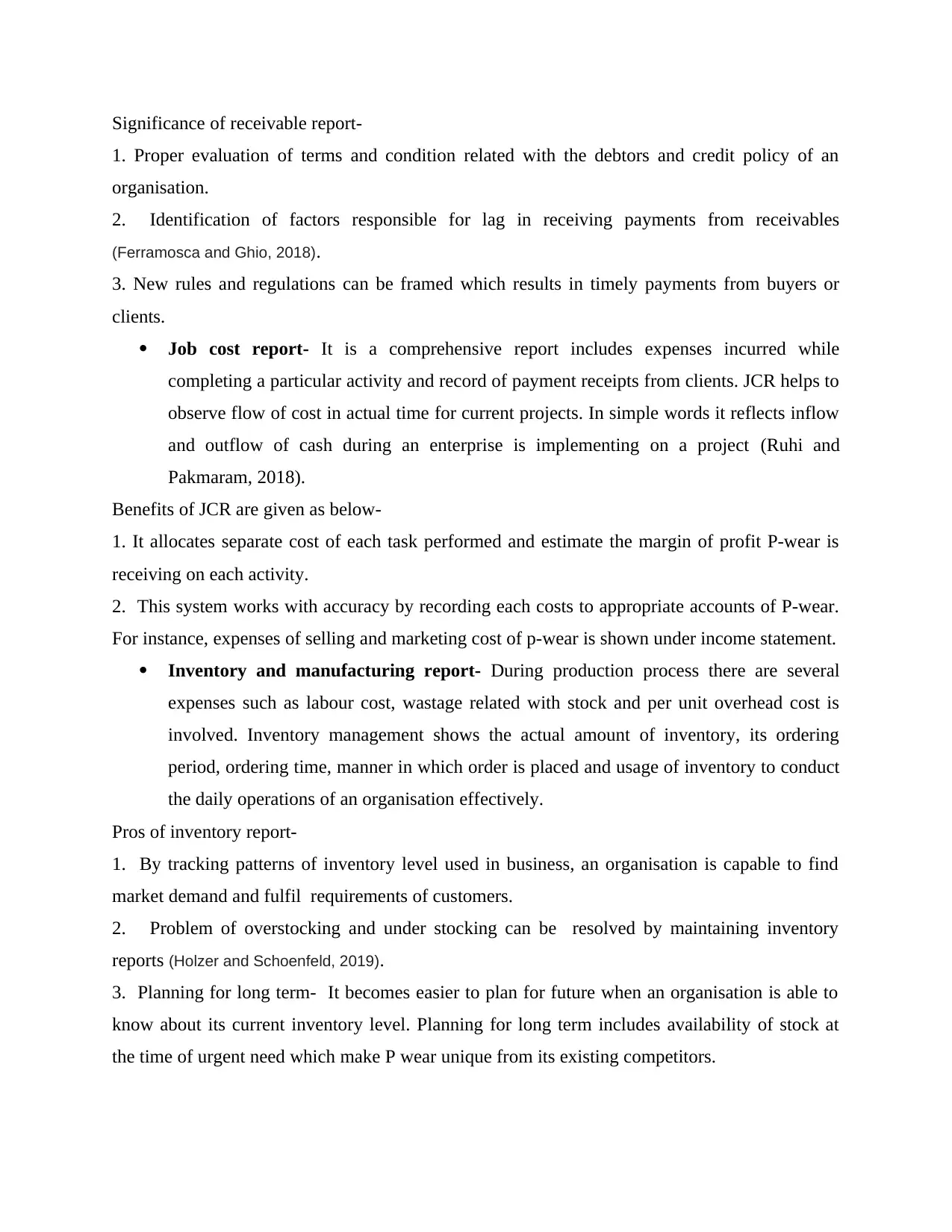
Significance of receivable report-
1. Proper evaluation of terms and condition related with the debtors and credit policy of an
organisation.
2. Identification of factors responsible for lag in receiving payments from receivables
(Ferramosca and Ghio, 2018).
3. New rules and regulations can be framed which results in timely payments from buyers or
clients.
Job cost report- It is a comprehensive report includes expenses incurred while
completing a particular activity and record of payment receipts from clients. JCR helps to
observe flow of cost in actual time for current projects. In simple words it reflects inflow
and outflow of cash during an enterprise is implementing on a project (Ruhi and
Pakmaram, 2018).
Benefits of JCR are given as below-
1. It allocates separate cost of each task performed and estimate the margin of profit P-wear is
receiving on each activity.
2. This system works with accuracy by recording each costs to appropriate accounts of P-wear.
For instance, expenses of selling and marketing cost of p-wear is shown under income statement.
Inventory and manufacturing report- During production process there are several
expenses such as labour cost, wastage related with stock and per unit overhead cost is
involved. Inventory management shows the actual amount of inventory, its ordering
period, ordering time, manner in which order is placed and usage of inventory to conduct
the daily operations of an organisation effectively.
Pros of inventory report-
1. By tracking patterns of inventory level used in business, an organisation is capable to find
market demand and fulfil requirements of customers.
2. Problem of overstocking and under stocking can be resolved by maintaining inventory
reports (Holzer and Schoenfeld, 2019).
3. Planning for long term- It becomes easier to plan for future when an organisation is able to
know about its current inventory level. Planning for long term includes availability of stock at
the time of urgent need which make P wear unique from its existing competitors.
1. Proper evaluation of terms and condition related with the debtors and credit policy of an
organisation.
2. Identification of factors responsible for lag in receiving payments from receivables
(Ferramosca and Ghio, 2018).
3. New rules and regulations can be framed which results in timely payments from buyers or
clients.
Job cost report- It is a comprehensive report includes expenses incurred while
completing a particular activity and record of payment receipts from clients. JCR helps to
observe flow of cost in actual time for current projects. In simple words it reflects inflow
and outflow of cash during an enterprise is implementing on a project (Ruhi and
Pakmaram, 2018).
Benefits of JCR are given as below-
1. It allocates separate cost of each task performed and estimate the margin of profit P-wear is
receiving on each activity.
2. This system works with accuracy by recording each costs to appropriate accounts of P-wear.
For instance, expenses of selling and marketing cost of p-wear is shown under income statement.
Inventory and manufacturing report- During production process there are several
expenses such as labour cost, wastage related with stock and per unit overhead cost is
involved. Inventory management shows the actual amount of inventory, its ordering
period, ordering time, manner in which order is placed and usage of inventory to conduct
the daily operations of an organisation effectively.
Pros of inventory report-
1. By tracking patterns of inventory level used in business, an organisation is capable to find
market demand and fulfil requirements of customers.
2. Problem of overstocking and under stocking can be resolved by maintaining inventory
reports (Holzer and Schoenfeld, 2019).
3. Planning for long term- It becomes easier to plan for future when an organisation is able to
know about its current inventory level. Planning for long term includes availability of stock at
the time of urgent need which make P wear unique from its existing competitors.
⊘ This is a preview!⊘
Do you want full access?
Subscribe today to unlock all pages.

Trusted by 1+ million students worldwide
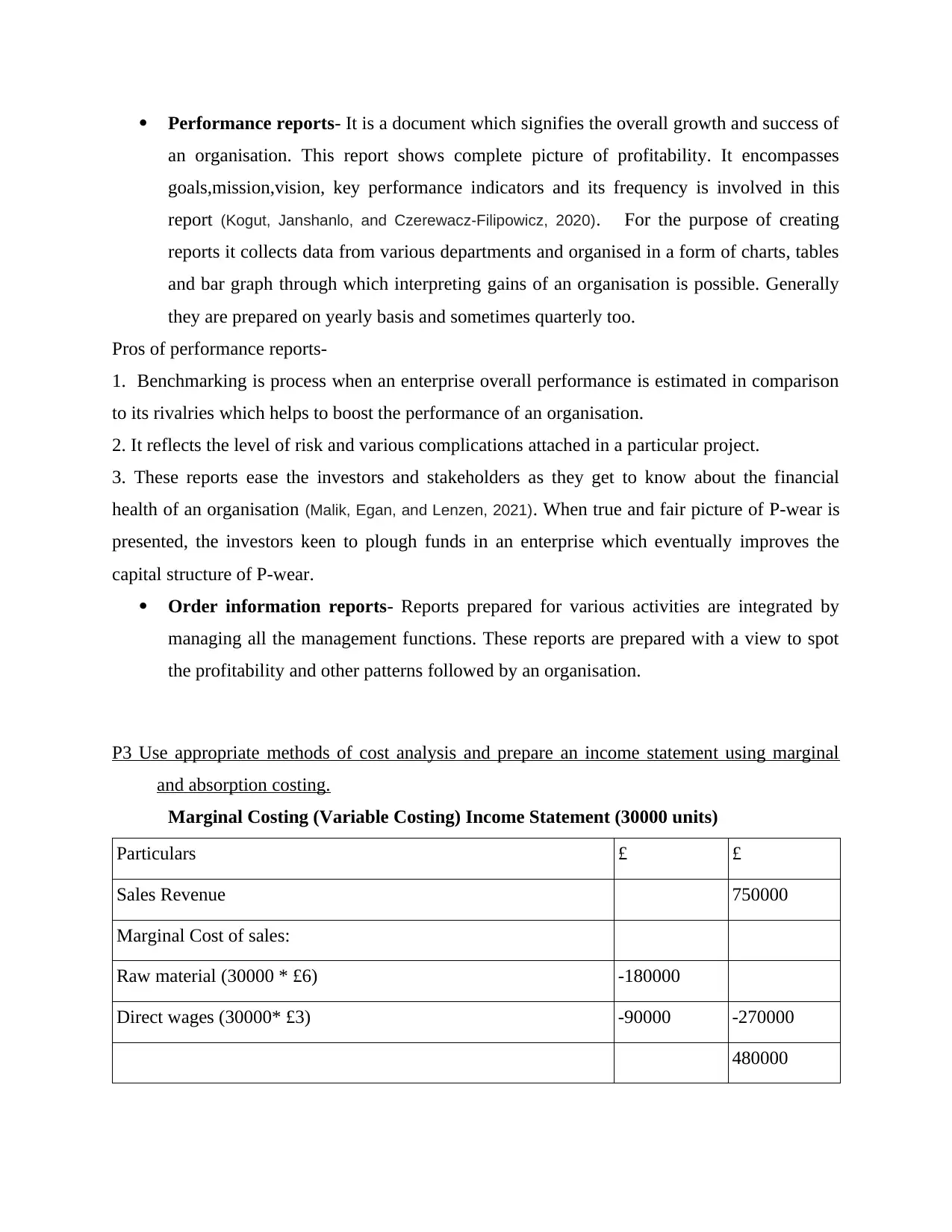
Performance reports- It is a document which signifies the overall growth and success of
an organisation. This report shows complete picture of profitability. It encompasses
goals,mission,vision, key performance indicators and its frequency is involved in this
report (Kogut, Janshanlo, and Czerewacz-Filipowicz, 2020). For the purpose of creating
reports it collects data from various departments and organised in a form of charts, tables
and bar graph through which interpreting gains of an organisation is possible. Generally
they are prepared on yearly basis and sometimes quarterly too.
Pros of performance reports-
1. Benchmarking is process when an enterprise overall performance is estimated in comparison
to its rivalries which helps to boost the performance of an organisation.
2. It reflects the level of risk and various complications attached in a particular project.
3. These reports ease the investors and stakeholders as they get to know about the financial
health of an organisation (Malik, Egan, and Lenzen, 2021). When true and fair picture of P-wear is
presented, the investors keen to plough funds in an enterprise which eventually improves the
capital structure of P-wear.
Order information reports- Reports prepared for various activities are integrated by
managing all the management functions. These reports are prepared with a view to spot
the profitability and other patterns followed by an organisation.
P3 Use appropriate methods of cost analysis and prepare an income statement using marginal
and absorption costing.
Marginal Costing (Variable Costing) Income Statement (30000 units)
Particulars £ £
Sales Revenue 750000
Marginal Cost of sales:
Raw material (30000 * £6) -180000
Direct wages (30000* £3) -90000 -270000
480000
an organisation. This report shows complete picture of profitability. It encompasses
goals,mission,vision, key performance indicators and its frequency is involved in this
report (Kogut, Janshanlo, and Czerewacz-Filipowicz, 2020). For the purpose of creating
reports it collects data from various departments and organised in a form of charts, tables
and bar graph through which interpreting gains of an organisation is possible. Generally
they are prepared on yearly basis and sometimes quarterly too.
Pros of performance reports-
1. Benchmarking is process when an enterprise overall performance is estimated in comparison
to its rivalries which helps to boost the performance of an organisation.
2. It reflects the level of risk and various complications attached in a particular project.
3. These reports ease the investors and stakeholders as they get to know about the financial
health of an organisation (Malik, Egan, and Lenzen, 2021). When true and fair picture of P-wear is
presented, the investors keen to plough funds in an enterprise which eventually improves the
capital structure of P-wear.
Order information reports- Reports prepared for various activities are integrated by
managing all the management functions. These reports are prepared with a view to spot
the profitability and other patterns followed by an organisation.
P3 Use appropriate methods of cost analysis and prepare an income statement using marginal
and absorption costing.
Marginal Costing (Variable Costing) Income Statement (30000 units)
Particulars £ £
Sales Revenue 750000
Marginal Cost of sales:
Raw material (30000 * £6) -180000
Direct wages (30000* £3) -90000 -270000
480000
Paraphrase This Document
Need a fresh take? Get an instant paraphrase of this document with our AI Paraphraser
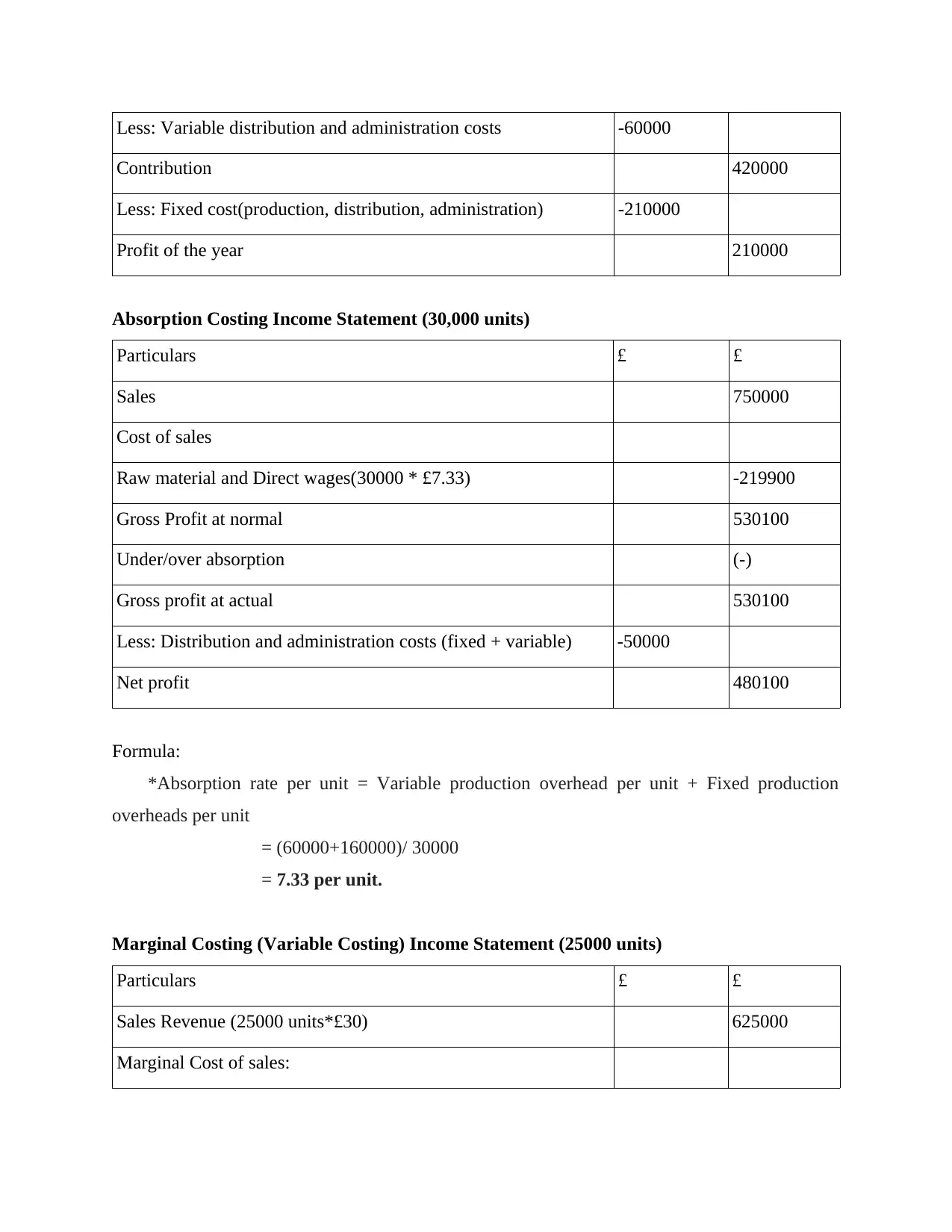
Less: Variable distribution and administration costs -60000
Contribution 420000
Less: Fixed cost(production, distribution, administration) -210000
Profit of the year 210000
Absorption Costing Income Statement (30,000 units)
Particulars £ £
Sales 750000
Cost of sales
Raw material and Direct wages(30000 * £7.33) -219900
Gross Profit at normal 530100
Under/over absorption (-)
Gross profit at actual 530100
Less: Distribution and administration costs (fixed + variable) -50000
Net profit 480100
Formula:
*Absorption rate per unit = Variable production overhead per unit + Fixed production
overheads per unit
= (60000+160000)/ 30000
= 7.33 per unit.
Marginal Costing (Variable Costing) Income Statement (25000 units)
Particulars £ £
Sales Revenue (25000 units*£30) 625000
Marginal Cost of sales:
Contribution 420000
Less: Fixed cost(production, distribution, administration) -210000
Profit of the year 210000
Absorption Costing Income Statement (30,000 units)
Particulars £ £
Sales 750000
Cost of sales
Raw material and Direct wages(30000 * £7.33) -219900
Gross Profit at normal 530100
Under/over absorption (-)
Gross profit at actual 530100
Less: Distribution and administration costs (fixed + variable) -50000
Net profit 480100
Formula:
*Absorption rate per unit = Variable production overhead per unit + Fixed production
overheads per unit
= (60000+160000)/ 30000
= 7.33 per unit.
Marginal Costing (Variable Costing) Income Statement (25000 units)
Particulars £ £
Sales Revenue (25000 units*£30) 625000
Marginal Cost of sales:
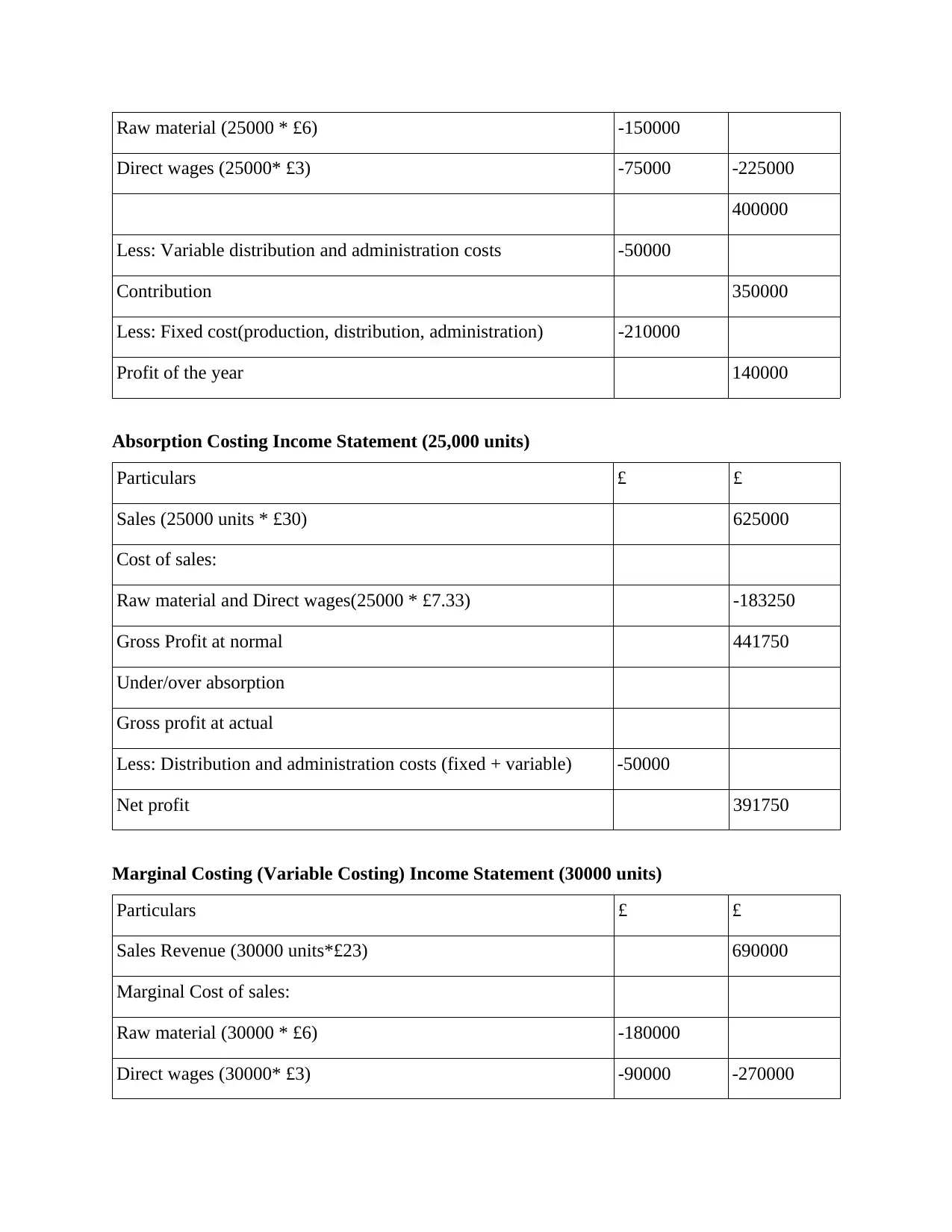
Raw material (25000 * £6) -150000
Direct wages (25000* £3) -75000 -225000
400000
Less: Variable distribution and administration costs -50000
Contribution 350000
Less: Fixed cost(production, distribution, administration) -210000
Profit of the year 140000
Absorption Costing Income Statement (25,000 units)
Particulars £ £
Sales (25000 units * £30) 625000
Cost of sales:
Raw material and Direct wages(25000 * £7.33) -183250
Gross Profit at normal 441750
Under/over absorption
Gross profit at actual
Less: Distribution and administration costs (fixed + variable) -50000
Net profit 391750
Marginal Costing (Variable Costing) Income Statement (30000 units)
Particulars £ £
Sales Revenue (30000 units*£23) 690000
Marginal Cost of sales:
Raw material (30000 * £6) -180000
Direct wages (30000* £3) -90000 -270000
Direct wages (25000* £3) -75000 -225000
400000
Less: Variable distribution and administration costs -50000
Contribution 350000
Less: Fixed cost(production, distribution, administration) -210000
Profit of the year 140000
Absorption Costing Income Statement (25,000 units)
Particulars £ £
Sales (25000 units * £30) 625000
Cost of sales:
Raw material and Direct wages(25000 * £7.33) -183250
Gross Profit at normal 441750
Under/over absorption
Gross profit at actual
Less: Distribution and administration costs (fixed + variable) -50000
Net profit 391750
Marginal Costing (Variable Costing) Income Statement (30000 units)
Particulars £ £
Sales Revenue (30000 units*£23) 690000
Marginal Cost of sales:
Raw material (30000 * £6) -180000
Direct wages (30000* £3) -90000 -270000
⊘ This is a preview!⊘
Do you want full access?
Subscribe today to unlock all pages.

Trusted by 1+ million students worldwide
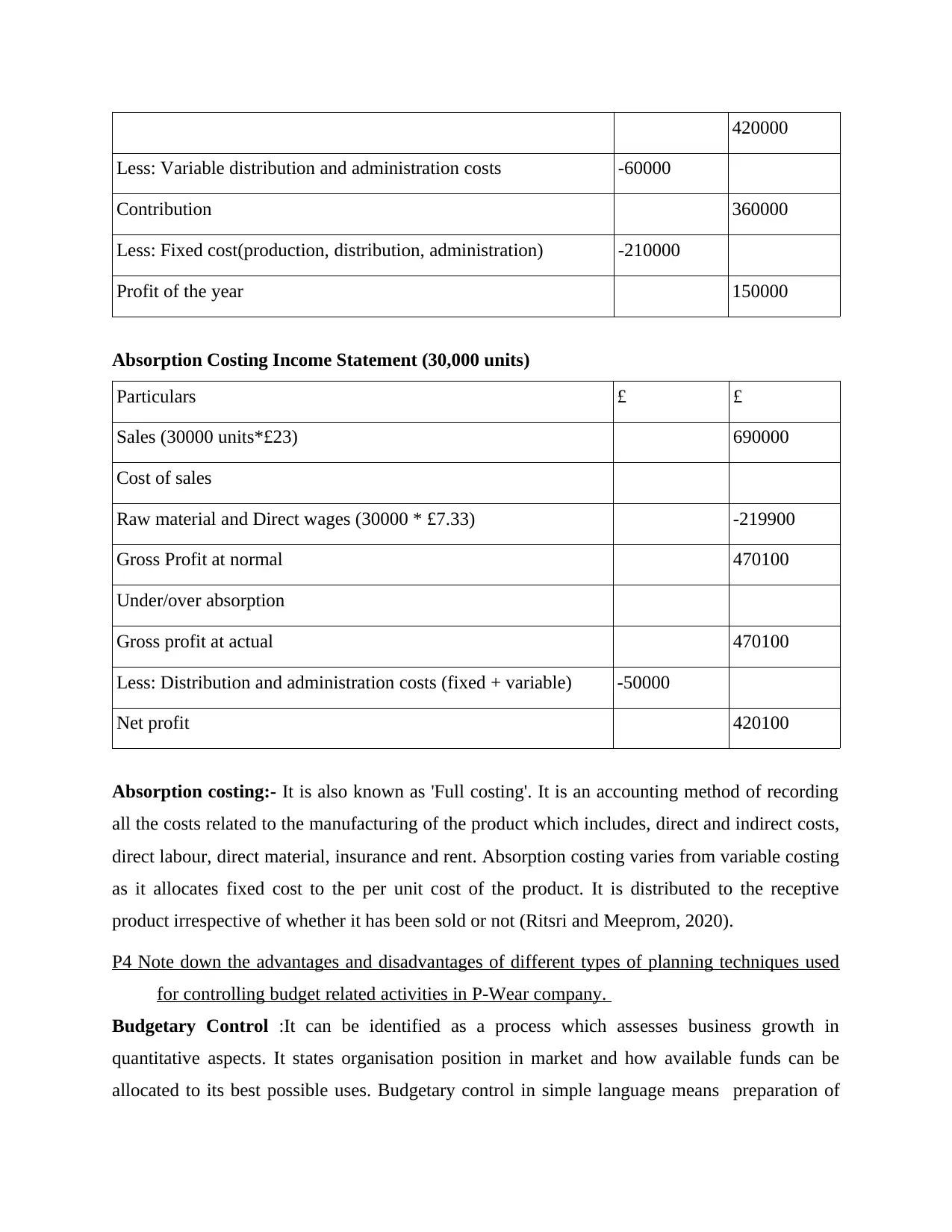
420000
Less: Variable distribution and administration costs -60000
Contribution 360000
Less: Fixed cost(production, distribution, administration) -210000
Profit of the year 150000
Absorption Costing Income Statement (30,000 units)
Particulars £ £
Sales (30000 units*£23) 690000
Cost of sales
Raw material and Direct wages (30000 * £7.33) -219900
Gross Profit at normal 470100
Under/over absorption
Gross profit at actual 470100
Less: Distribution and administration costs (fixed + variable) -50000
Net profit 420100
Absorption costing:- It is also known as 'Full costing'. It is an accounting method of recording
all the costs related to the manufacturing of the product which includes, direct and indirect costs,
direct labour, direct material, insurance and rent. Absorption costing varies from variable costing
as it allocates fixed cost to the per unit cost of the product. It is distributed to the receptive
product irrespective of whether it has been sold or not (Ritsri and Meeprom, 2020).
P4 Note down the advantages and disadvantages of different types of planning techniques used
for controlling budget related activities in P-Wear company.
Budgetary Control :It can be identified as a process which assesses business growth in
quantitative aspects. It states organisation position in market and how available funds can be
allocated to its best possible uses. Budgetary control in simple language means preparation of
Less: Variable distribution and administration costs -60000
Contribution 360000
Less: Fixed cost(production, distribution, administration) -210000
Profit of the year 150000
Absorption Costing Income Statement (30,000 units)
Particulars £ £
Sales (30000 units*£23) 690000
Cost of sales
Raw material and Direct wages (30000 * £7.33) -219900
Gross Profit at normal 470100
Under/over absorption
Gross profit at actual 470100
Less: Distribution and administration costs (fixed + variable) -50000
Net profit 420100
Absorption costing:- It is also known as 'Full costing'. It is an accounting method of recording
all the costs related to the manufacturing of the product which includes, direct and indirect costs,
direct labour, direct material, insurance and rent. Absorption costing varies from variable costing
as it allocates fixed cost to the per unit cost of the product. It is distributed to the receptive
product irrespective of whether it has been sold or not (Ritsri and Meeprom, 2020).
P4 Note down the advantages and disadvantages of different types of planning techniques used
for controlling budget related activities in P-Wear company.
Budgetary Control :It can be identified as a process which assesses business growth in
quantitative aspects. It states organisation position in market and how available funds can be
allocated to its best possible uses. Budgetary control in simple language means preparation of
Paraphrase This Document
Need a fresh take? Get an instant paraphrase of this document with our AI Paraphraser
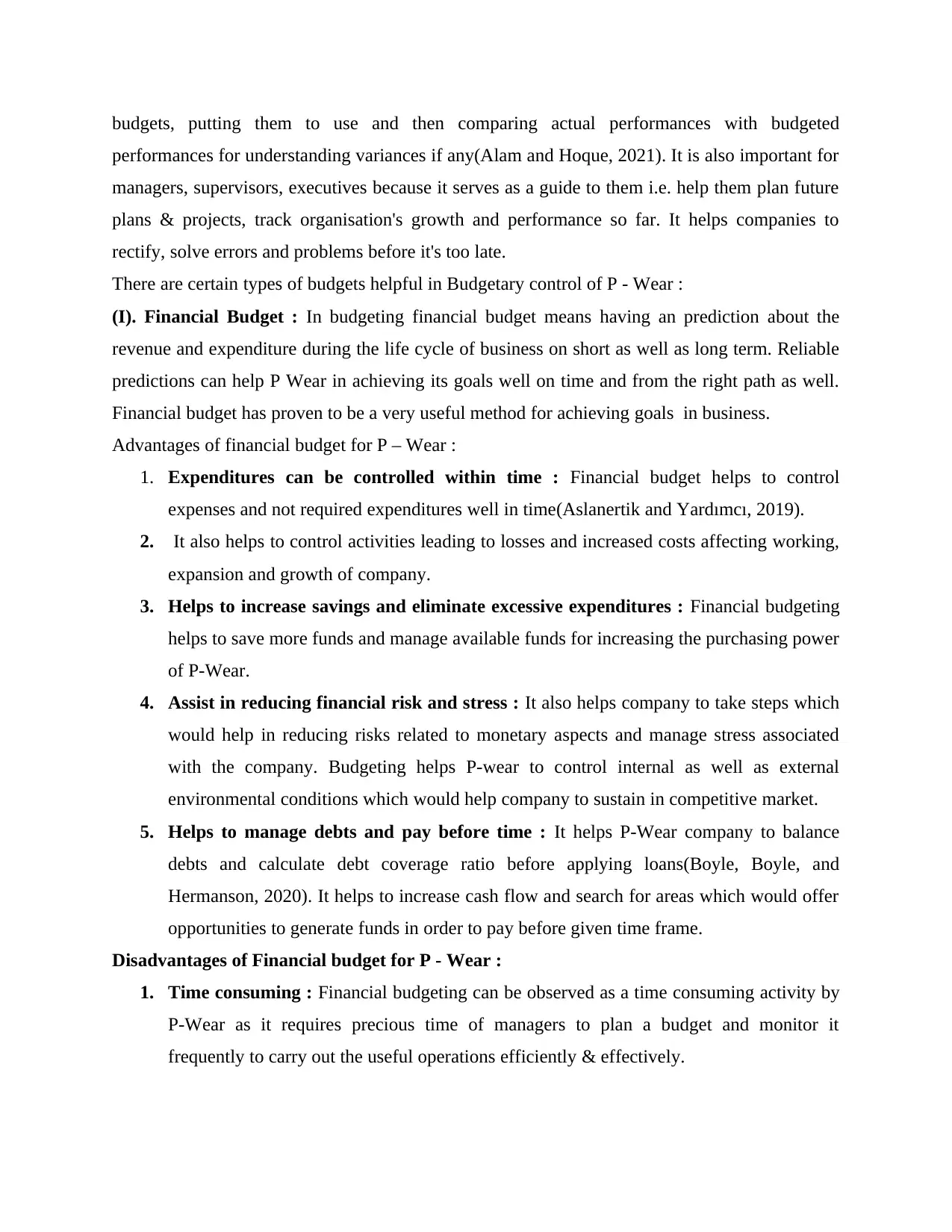
budgets, putting them to use and then comparing actual performances with budgeted
performances for understanding variances if any(Alam and Hoque, 2021). It is also important for
managers, supervisors, executives because it serves as a guide to them i.e. help them plan future
plans & projects, track organisation's growth and performance so far. It helps companies to
rectify, solve errors and problems before it's too late.
There are certain types of budgets helpful in Budgetary control of P - Wear :
(I). Financial Budget : In budgeting financial budget means having an prediction about the
revenue and expenditure during the life cycle of business on short as well as long term. Reliable
predictions can help P Wear in achieving its goals well on time and from the right path as well.
Financial budget has proven to be a very useful method for achieving goals in business.
Advantages of financial budget for P – Wear :
1. Expenditures can be controlled within time : Financial budget helps to control
expenses and not required expenditures well in time(Aslanertik and Yardımcı, 2019).
2. It also helps to control activities leading to losses and increased costs affecting working,
expansion and growth of company.
3. Helps to increase savings and eliminate excessive expenditures : Financial budgeting
helps to save more funds and manage available funds for increasing the purchasing power
of P-Wear.
4. Assist in reducing financial risk and stress : It also helps company to take steps which
would help in reducing risks related to monetary aspects and manage stress associated
with the company. Budgeting helps P-wear to control internal as well as external
environmental conditions which would help company to sustain in competitive market.
5. Helps to manage debts and pay before time : It helps P-Wear company to balance
debts and calculate debt coverage ratio before applying loans(Boyle, Boyle, and
Hermanson, 2020). It helps to increase cash flow and search for areas which would offer
opportunities to generate funds in order to pay before given time frame.
Disadvantages of Financial budget for P - Wear :
1. Time consuming : Financial budgeting can be observed as a time consuming activity by
P-Wear as it requires precious time of managers to plan a budget and monitor it
frequently to carry out the useful operations efficiently & effectively.
performances for understanding variances if any(Alam and Hoque, 2021). It is also important for
managers, supervisors, executives because it serves as a guide to them i.e. help them plan future
plans & projects, track organisation's growth and performance so far. It helps companies to
rectify, solve errors and problems before it's too late.
There are certain types of budgets helpful in Budgetary control of P - Wear :
(I). Financial Budget : In budgeting financial budget means having an prediction about the
revenue and expenditure during the life cycle of business on short as well as long term. Reliable
predictions can help P Wear in achieving its goals well on time and from the right path as well.
Financial budget has proven to be a very useful method for achieving goals in business.
Advantages of financial budget for P – Wear :
1. Expenditures can be controlled within time : Financial budget helps to control
expenses and not required expenditures well in time(Aslanertik and Yardımcı, 2019).
2. It also helps to control activities leading to losses and increased costs affecting working,
expansion and growth of company.
3. Helps to increase savings and eliminate excessive expenditures : Financial budgeting
helps to save more funds and manage available funds for increasing the purchasing power
of P-Wear.
4. Assist in reducing financial risk and stress : It also helps company to take steps which
would help in reducing risks related to monetary aspects and manage stress associated
with the company. Budgeting helps P-wear to control internal as well as external
environmental conditions which would help company to sustain in competitive market.
5. Helps to manage debts and pay before time : It helps P-Wear company to balance
debts and calculate debt coverage ratio before applying loans(Boyle, Boyle, and
Hermanson, 2020). It helps to increase cash flow and search for areas which would offer
opportunities to generate funds in order to pay before given time frame.
Disadvantages of Financial budget for P - Wear :
1. Time consuming : Financial budgeting can be observed as a time consuming activity by
P-Wear as it requires precious time of managers to plan a budget and monitor it
frequently to carry out the useful operations efficiently & effectively.
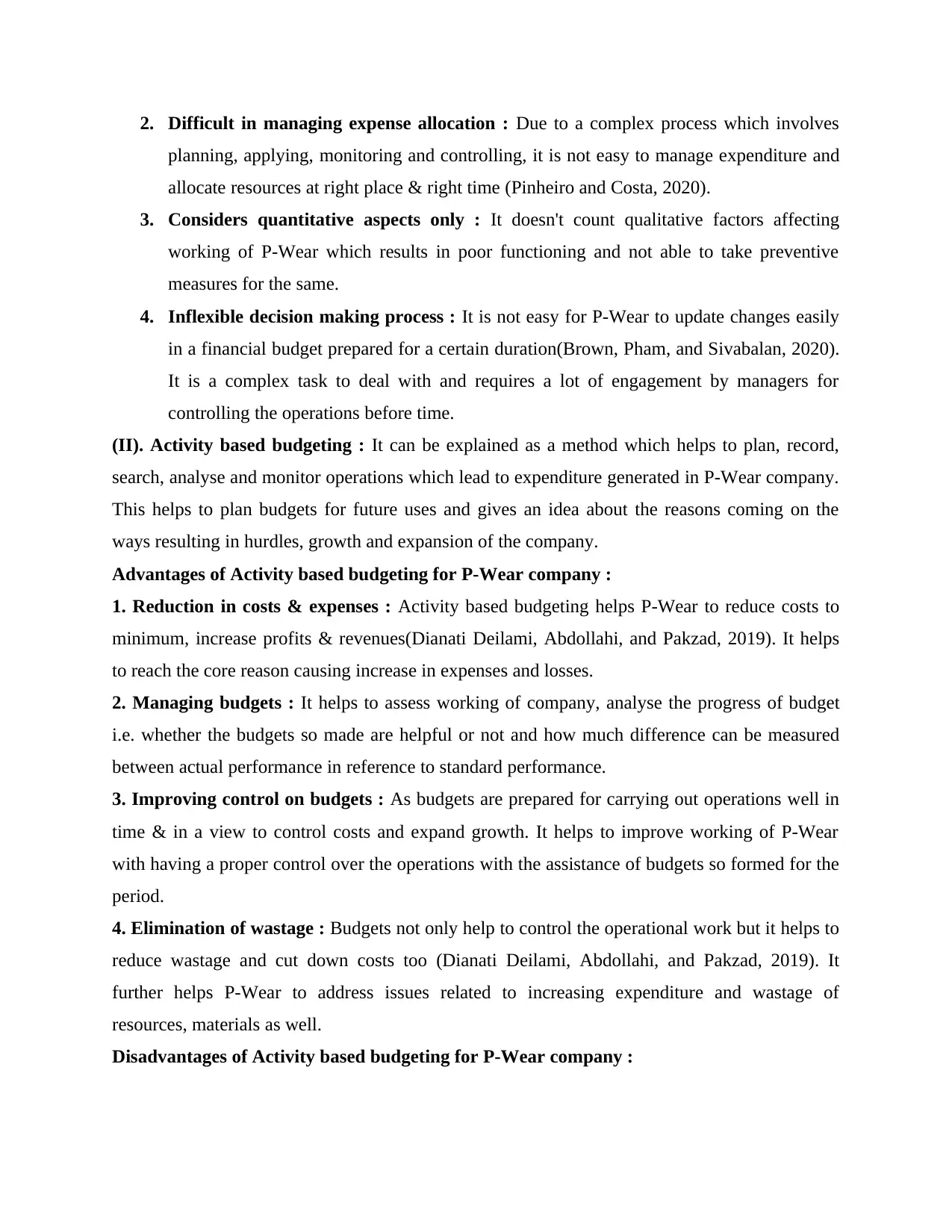
2. Difficult in managing expense allocation : Due to a complex process which involves
planning, applying, monitoring and controlling, it is not easy to manage expenditure and
allocate resources at right place & right time (Pinheiro and Costa, 2020).
3. Considers quantitative aspects only : It doesn't count qualitative factors affecting
working of P-Wear which results in poor functioning and not able to take preventive
measures for the same.
4. Inflexible decision making process : It is not easy for P-Wear to update changes easily
in a financial budget prepared for a certain duration(Brown, Pham, and Sivabalan, 2020).
It is a complex task to deal with and requires a lot of engagement by managers for
controlling the operations before time.
(II). Activity based budgeting : It can be explained as a method which helps to plan, record,
search, analyse and monitor operations which lead to expenditure generated in P-Wear company.
This helps to plan budgets for future uses and gives an idea about the reasons coming on the
ways resulting in hurdles, growth and expansion of the company.
Advantages of Activity based budgeting for P-Wear company :
1. Reduction in costs & expenses : Activity based budgeting helps P-Wear to reduce costs to
minimum, increase profits & revenues(Dianati Deilami, Abdollahi, and Pakzad, 2019). It helps
to reach the core reason causing increase in expenses and losses.
2. Managing budgets : It helps to assess working of company, analyse the progress of budget
i.e. whether the budgets so made are helpful or not and how much difference can be measured
between actual performance in reference to standard performance.
3. Improving control on budgets : As budgets are prepared for carrying out operations well in
time & in a view to control costs and expand growth. It helps to improve working of P-Wear
with having a proper control over the operations with the assistance of budgets so formed for the
period.
4. Elimination of wastage : Budgets not only help to control the operational work but it helps to
reduce wastage and cut down costs too (Dianati Deilami, Abdollahi, and Pakzad, 2019). It
further helps P-Wear to address issues related to increasing expenditure and wastage of
resources, materials as well.
Disadvantages of Activity based budgeting for P-Wear company :
planning, applying, monitoring and controlling, it is not easy to manage expenditure and
allocate resources at right place & right time (Pinheiro and Costa, 2020).
3. Considers quantitative aspects only : It doesn't count qualitative factors affecting
working of P-Wear which results in poor functioning and not able to take preventive
measures for the same.
4. Inflexible decision making process : It is not easy for P-Wear to update changes easily
in a financial budget prepared for a certain duration(Brown, Pham, and Sivabalan, 2020).
It is a complex task to deal with and requires a lot of engagement by managers for
controlling the operations before time.
(II). Activity based budgeting : It can be explained as a method which helps to plan, record,
search, analyse and monitor operations which lead to expenditure generated in P-Wear company.
This helps to plan budgets for future uses and gives an idea about the reasons coming on the
ways resulting in hurdles, growth and expansion of the company.
Advantages of Activity based budgeting for P-Wear company :
1. Reduction in costs & expenses : Activity based budgeting helps P-Wear to reduce costs to
minimum, increase profits & revenues(Dianati Deilami, Abdollahi, and Pakzad, 2019). It helps
to reach the core reason causing increase in expenses and losses.
2. Managing budgets : It helps to assess working of company, analyse the progress of budget
i.e. whether the budgets so made are helpful or not and how much difference can be measured
between actual performance in reference to standard performance.
3. Improving control on budgets : As budgets are prepared for carrying out operations well in
time & in a view to control costs and expand growth. It helps to improve working of P-Wear
with having a proper control over the operations with the assistance of budgets so formed for the
period.
4. Elimination of wastage : Budgets not only help to control the operational work but it helps to
reduce wastage and cut down costs too (Dianati Deilami, Abdollahi, and Pakzad, 2019). It
further helps P-Wear to address issues related to increasing expenditure and wastage of
resources, materials as well.
Disadvantages of Activity based budgeting for P-Wear company :
⊘ This is a preview!⊘
Do you want full access?
Subscribe today to unlock all pages.

Trusted by 1+ million students worldwide
1 out of 22
Related Documents
Your All-in-One AI-Powered Toolkit for Academic Success.
+13062052269
info@desklib.com
Available 24*7 on WhatsApp / Email
![[object Object]](/_next/static/media/star-bottom.7253800d.svg)
Unlock your academic potential
Copyright © 2020–2025 A2Z Services. All Rights Reserved. Developed and managed by ZUCOL.





